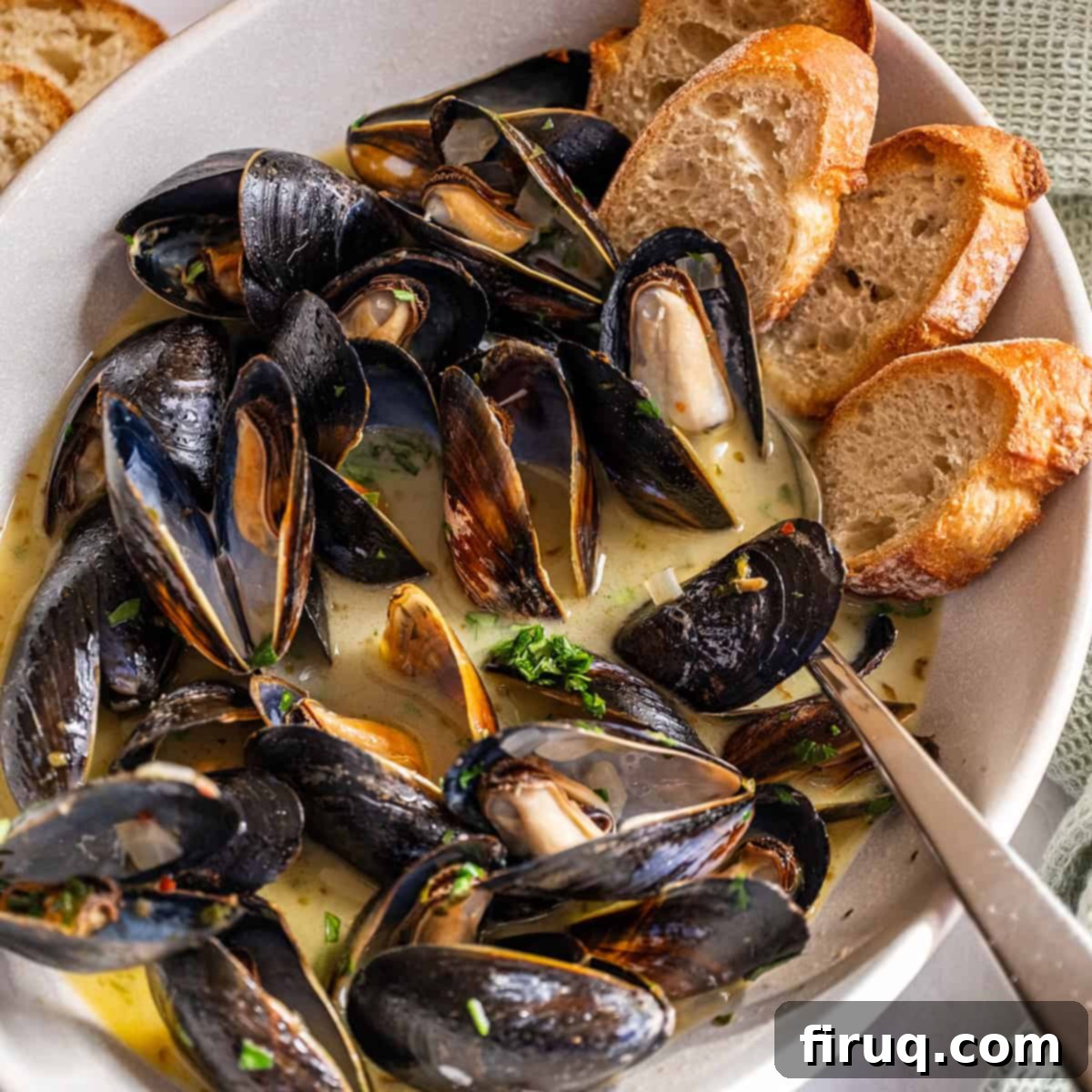Easy Steamed Mussels in White Wine Sauce: A 30-Minute Culinary Delight
Steamed Mussels in White Wine Sauce offers an exquisite culinary experience with minimal effort. This delectable dish features succulent mussels bathed in a rich, buttery, and bright sauce, expertly flavored with aromatic garlic and delicate shallots. It’s the quintessential sauce, perfect for basting the plump mussels and, perhaps even more importantly, for dipping generous pieces of crusty Italian bread or toasted crostini.
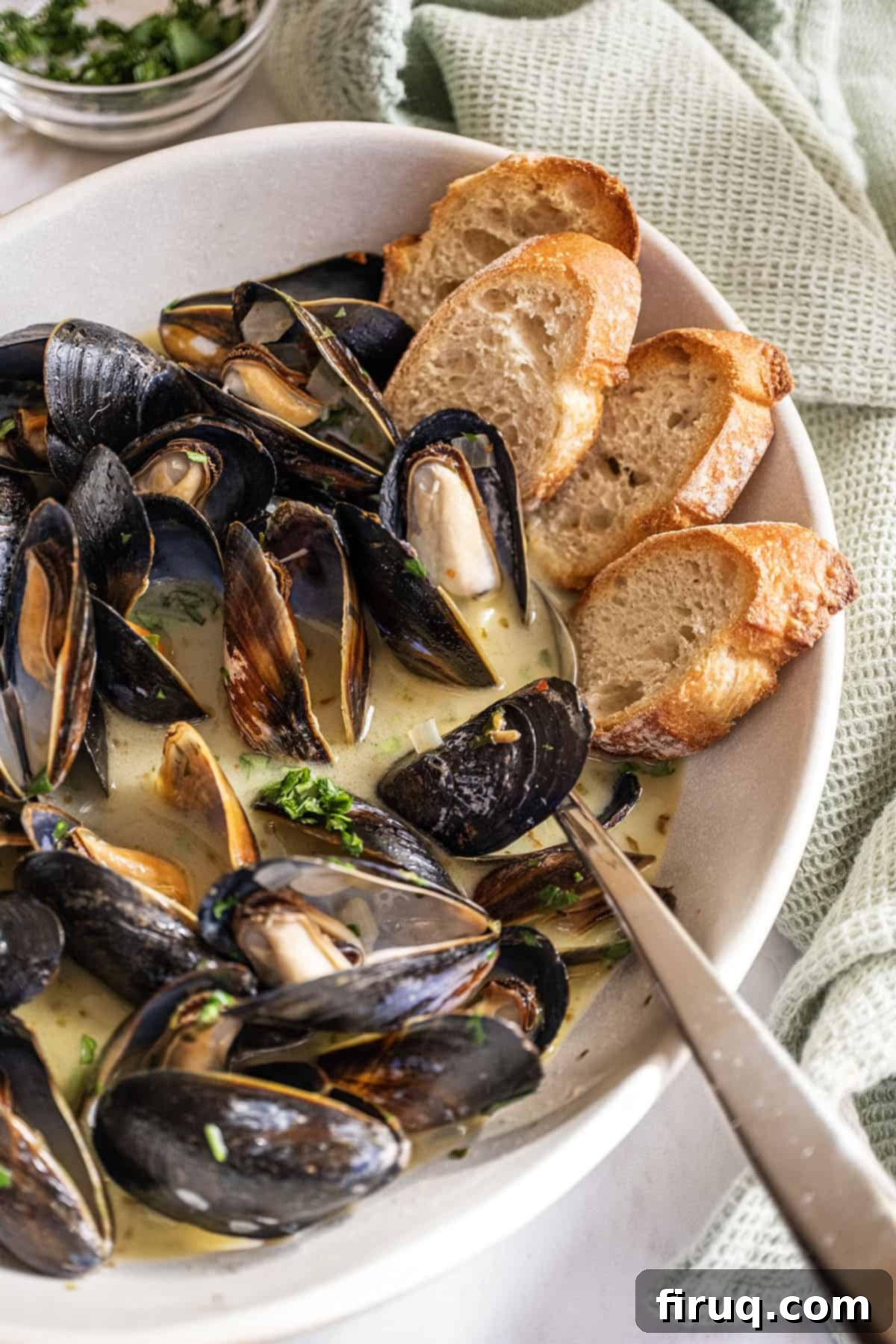
If you’re seeking more exquisite seafood appetizers to tantalize your taste buds, explore our recipes for Homemade Shrimp Cocktail or Garlic Sage Seared Scallops. Each offers a unique burst of flavor, perfect for any gathering.
[feast_advanced_jump_to]Discover the Simplicity of This Easy Mussels Recipe
This remarkable 30-minute mussels recipe is not only incredibly easy to prepare but also exceptionally delicious and versatile. It can effortlessly adapt to various dining occasions, whether as an elegant appetizer or a satisfying main course. I particularly love to serve it alongside a generous loaf of crusty Italian bread or toasted crostini, allowing everyone to soak up every drop of that incredible sauce. For a more substantial meal, it pairs wonderfully with a side of pasta, such as a rich and creamy Spaghetti Carbonara!
Growing up, my parents had a delightful, albeit persistent, mission to introduce us to the joys of seafood. Trying new fish and shellfish was practically a rite of passage in our home. I remember my dad vividly claiming that eating fresh clams, much like our beloved Italian Stuffed Baked Clams, would put “hair on my chest!” While that particular outcome remains unverified, the appreciation for fresh, flavorful seafood certainly stuck.
Steamed Mussels in White Wine sauce stands out for its delicate, mild flavor, making it an excellent introduction to shellfish for newcomers. Even if you’re initially hesitant about the mussels themselves, the accompanying sauce is so enticing that you can simply dip your bread into it, gradually accustoming your palate to the exquisite taste. This luscious sauce is, without a doubt, one of the best parts of mussel dishes, whether it’s this recipe or a spicier creation like Mussels Fra Diavolo. The balance of butter, garlic, shallots, and white wine creates a truly unforgettable experience.
Selecting the Best Mussels: A Guide to Smart Shopping
When it comes to purchasing mussels, you’ll find that most varieties available in stores are farm-raised. And that’s perfectly fine—in fact, it’s often preferable! While the idea of wild mussels might sound appealing, they come with a few considerations. Wild mussels tend to carry a significant amount of grit and sand, as they live directly on the ocean floor. Furthermore, if harvested from certain regions, such as the California coast, they can be unsafe to consume during specific periods of the year due to potential toxins. Mussels are indiscriminate filter feeders, meaning they will consume anything in their environment, including pollutants or harmful microorganisms, which can make them dangerous for human consumption.
For these reasons, it’s almost always a better choice to opt for rope-grown, farm-raised mussels. These mussels are cultivated in controlled environments, typically suspended from ropes, preventing them from settling on the seabed. This method results in cleaner mussels with far less grit and a more consistent, safer product. This preference for farm-raised mussels is quite different from salmon, where wild-caught varieties are often sought after for their flavor and nutritional profile, as seen in our Cast Iron Lemon Dill Salmon recipe. For mussels, quality and safety lead us to the farm.
The wild mussels also will have a lot of grit and sand because they live on the ocean floor. They require extensive purging—a process of soaking them in clean water—to remove all the unwanted sand and debris that you definitely don’t want ending up in your delicious white wine sauce. Farm-raised mussels significantly reduce, if not eliminate, the need for this time-consuming step.
When you’re at the seafood counter, look for mussels with tightly closed shells. If any are slightly open, give them a gentle tap. They should close firmly within a few seconds. If they remain open, discard them, as they are likely dead. Always aim for mussels that smell fresh, like the ocean, not overly fishy.
Preparing Your Mussels: Essential Cleaning Tips
Once you’ve brought your fresh mussels home, a proper cleaning is crucial, regardless of whether they are farm-raised or wild. Both types can still have “beards” – the fibrous, hairy growths protruding from the edge of the shell. This beard needs to be removed before cooking. To do this, simply hold the mussel firmly in one hand and grab the beard tightly between your thumb and forefinger, then rip it out of the shell with a firm tug. Don’t worry, it’s easier than it sounds!
Beyond debearding, both farm-raised and wild mussels should be thoroughly scrubbed before they hit the pan. You can do this with your hands under cold running water, rubbing the shells together to remove any grit or debris, or by using a clean brush. This step ensures that your delicious white wine sauce remains perfectly clean and free of unwanted sandy textures.
Crucially, before cooking, you must inspect and discard any open or broken shells. Mussels with open shells that do not close when tapped are dead and can spoil rapidly, posing a health risk. Only cook mussels that have a closed shell. If a mussel is slightly open, gently tap the shell against the counter or another mussel. If it closes up tightly within a few seconds, it’s alive and perfectly safe to eat. This “tap test” is a simple yet vital step in ensuring a safe and enjoyable meal.
Ingredient Spotlight: Tips for Perfect Steamed Mussels
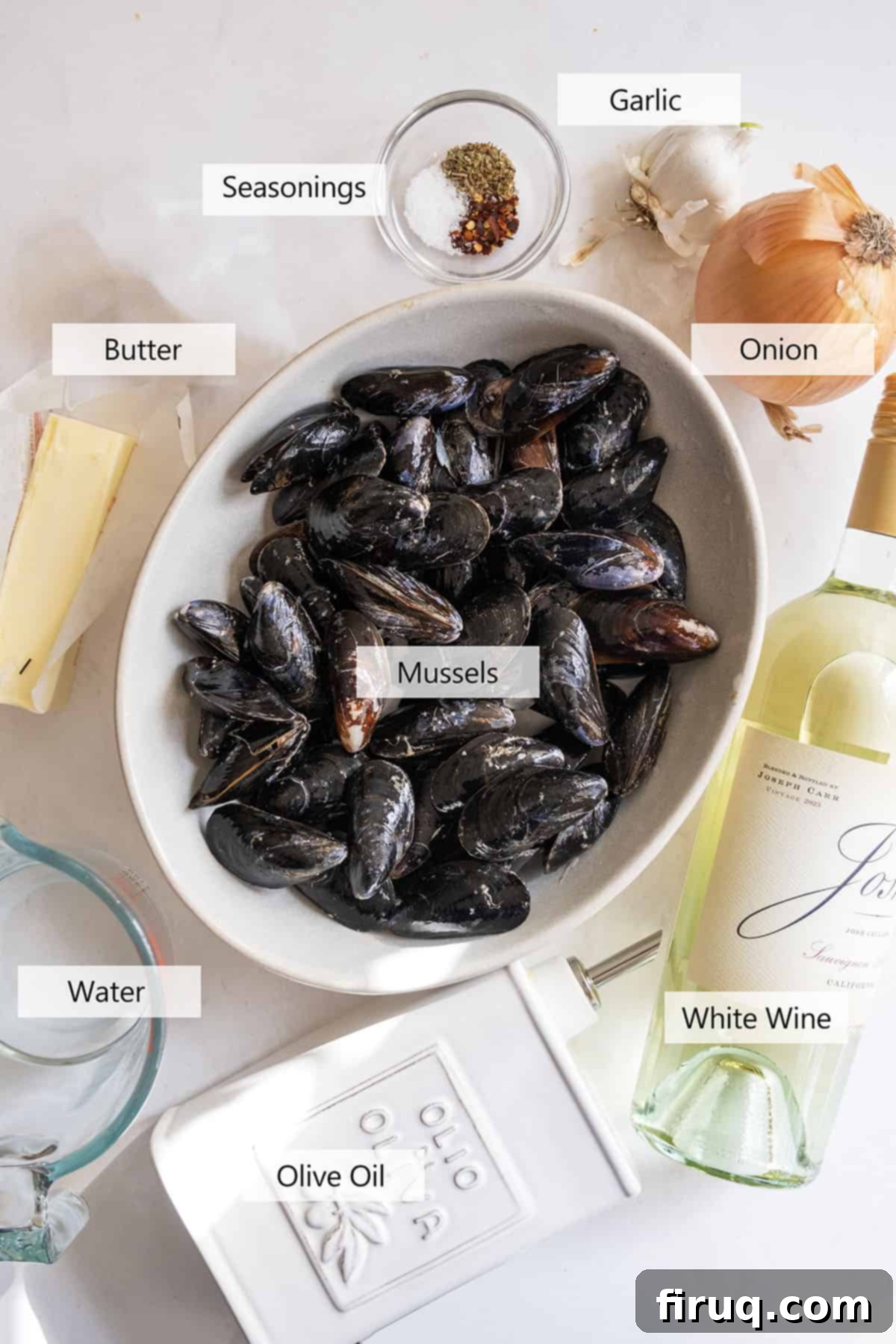
- Shallot: While the image shows an onion, I highly recommend using a shallot for this recipe. Shallots offer a milder, sweeter, and more delicate flavor profile compared to regular onions, which beautifully complements the subtle taste of mussels and garlic in the sauce. If shallots are unavailable, a very finely diced small yellow onion can be used, but be mindful of its stronger flavor.
- White Wine: The choice of white wine is paramount for the depth of flavor in your sauce. People frequently ask what type of white wine is best for cooking. My go-to is almost always a dry white wine like Sauvignon Blanc or Pinot Grigio. These varietals are known for their bright, crisp, and fresh characteristics, which infuse the mussels with a fantastic aroma and taste. A crucial rule of thumb: only cook with wine you would actually drink! If it’s not good enough to sip, it’s not good enough for your delicious mussels.
- Mussels: For this recipe, I used rope-grown, farm-raised mussels, specifically from Costco, which offers great value and consistently fresh, delicious mussels. When buying, always opt for fresh mussels with closed shells. While fresh is best, frozen mussels can be used in a pinch, though they may have a slightly different texture and less vibrant flavor. Ensure they are fully thawed and follow the same cleaning process.
- Seasonings: The beauty of this recipe lies in its simple yet impactful seasonings: dried oregano, a pinch of crushed red pepper flakes, and salt. Oregano lends an earthy, aromatic depth, while crushed red pepper provides a gentle warmth that enhances the seafood without overwhelming it. Salt, of course, balances all the flavors. These classic Italian-inspired seasonings work harmoniously to create a truly delicious broth. Freshly ground black pepper can also be added for an extra layer of flavor.
- Olive Oil: A good quality extra virgin olive oil provides the base for sautéing the aromatics and contributes to the richness of the sauce.
- Butter: Added at the end, butter emulsifies beautifully into the wine sauce, giving it a luscious, velvety texture and an extra layer of richness that truly elevates the dish.
- Fresh Parsley: Essential for a burst of fresh flavor and vibrant color, stirred into the sauce and used as a garnish.
*Please see the recipe card below for more detailed information on ingredients and exact measurements.
Crafting Perfection: How to Make Steamed Mussels in White Wine
The secret to truly outstanding steamed mussels lies in creating a good base sauce. This flavorful foundation doesn’t just steam the mussels; it infuses them with an unbelievable taste and aroma. And let’s be honest, dipping warm, crusty crostini into that savory sauce might just be the best part of the entire experience.
Before you begin cooking, the first crucial step is to meticulously clean and debeard your mussels. Detailed instructions for this essential preparation can be found above in the “How to Clean Mussels” section of this guide. Proper cleaning ensures a grit-free and delightful dining experience.
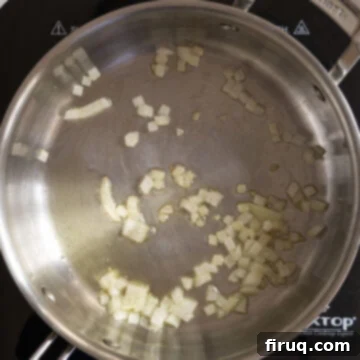
Step 1: Build the Aromatic Base. In a large, heavy-bottomed saucepan or Dutch oven, add your olive oil and bring it to medium-low heat. Once shimmering, stir in the chopped shallots. Sauté gently until they become soft and translucent, usually taking about 5 minutes. This slow sautéing allows the shallots to release their sweet, mild flavors without browning, creating a perfect foundation for the sauce.
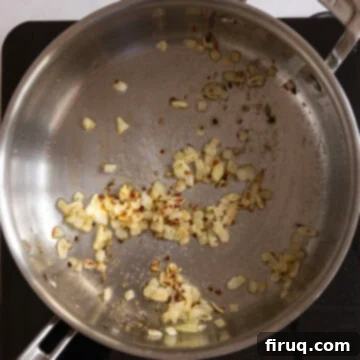
Step 2: Infuse with Garlic and Spices. Next, add the minced garlic, crushed red pepper flakes, and dried oregano to the pan. Stir continuously and sauté for just 1-2 minutes. The goal here is to allow the garlic to become wonderfully fragrant and soft, but crucially, to prevent it from browning, which can make it bitter. The crushed red pepper and oregano will release their aromatic oils, adding depth and a subtle hint of spice.
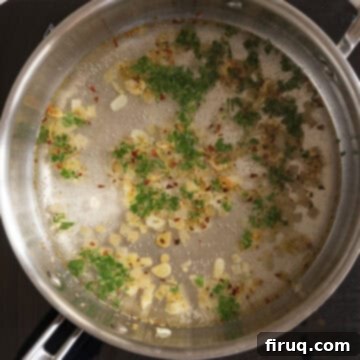
Step 3: Create the Steaming Liquid. Pour in 1 cup of dry white wine and ½ cup of water (or an equal amount of chicken or vegetable broth for extra depth, if preferred). Increase the heat to medium and bring the liquid to a gentle simmer. As it warms, stir in 1 tablespoon of fresh chopped parsley. Allow it to simmer for about 3 minutes; this brief period allows the alcohol to cook off and the flavors to meld beautifully, creating a fragrant and inviting broth.
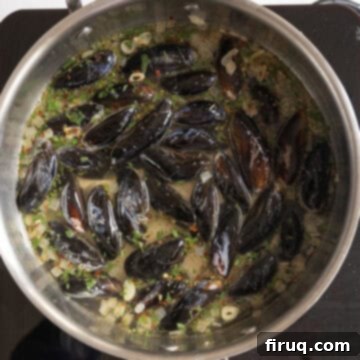
Step 4: Steam the Mussels to Perfection. Gently add the cleaned mussels into the simmering liquid. Cover the saucepan tightly with a lid and allow them to steam for 3-5 minutes. Keep the heat on a low simmer during this process. The steam will cook the mussels rapidly, and the tightly closed shells will naturally open as they cook, indicating they are done. Avoid overcooking, as this can make the mussels tough and rubbery.
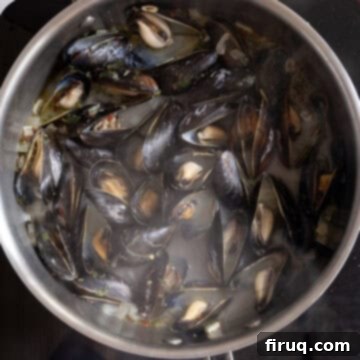
Step 5: Baste and Prepare for Serving. When you lift the lid, the mussels should be wide open, a clear sign they are perfectly cooked. Give the mussels a gentle stir, ensuring they are thoroughly basted in the aromatic white wine sauce. Carefully remove the opened mussels from the pan using a slotted spoon and transfer them to your chosen serving bowl, leaving the delicious cooking liquid behind.
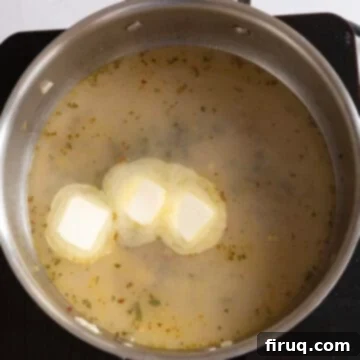
Step 6: Finish the Sauce and Serve. Now for the magic touch! Add the cold butter to the hot sauce remaining in the pan. Stir well until the butter has completely melted and is fully combined, creating a luscious, slightly thickened, and incredibly flavorful sauce. Pour this exquisite sauce generously over the mussels in the serving bowl. Serve immediately with plenty of toasted crostini or slices of crusty Italian bread for dipping. For a final flourish, garnish with an extra sprinkle of fresh parsley, adding both visual appeal and a burst of herbaceous freshness.
These exquisite steamed mussels in white wine are the perfect appetizer to grace your Christmas Eve feast or any holiday spread. They are incredibly easy to prepare and serve, and the best part is that it is a really quick recipe. Much of the prep work, such as cleaning the mussels or gathering ingredients, can be done in advance, making entertaining a breeze. While these mussels are cooking, you might want to put out other delightful snacks for your guests, such as our enticing Bourbon Candied Pecans or our simple yet delicious Easy Steamed Artichokes.
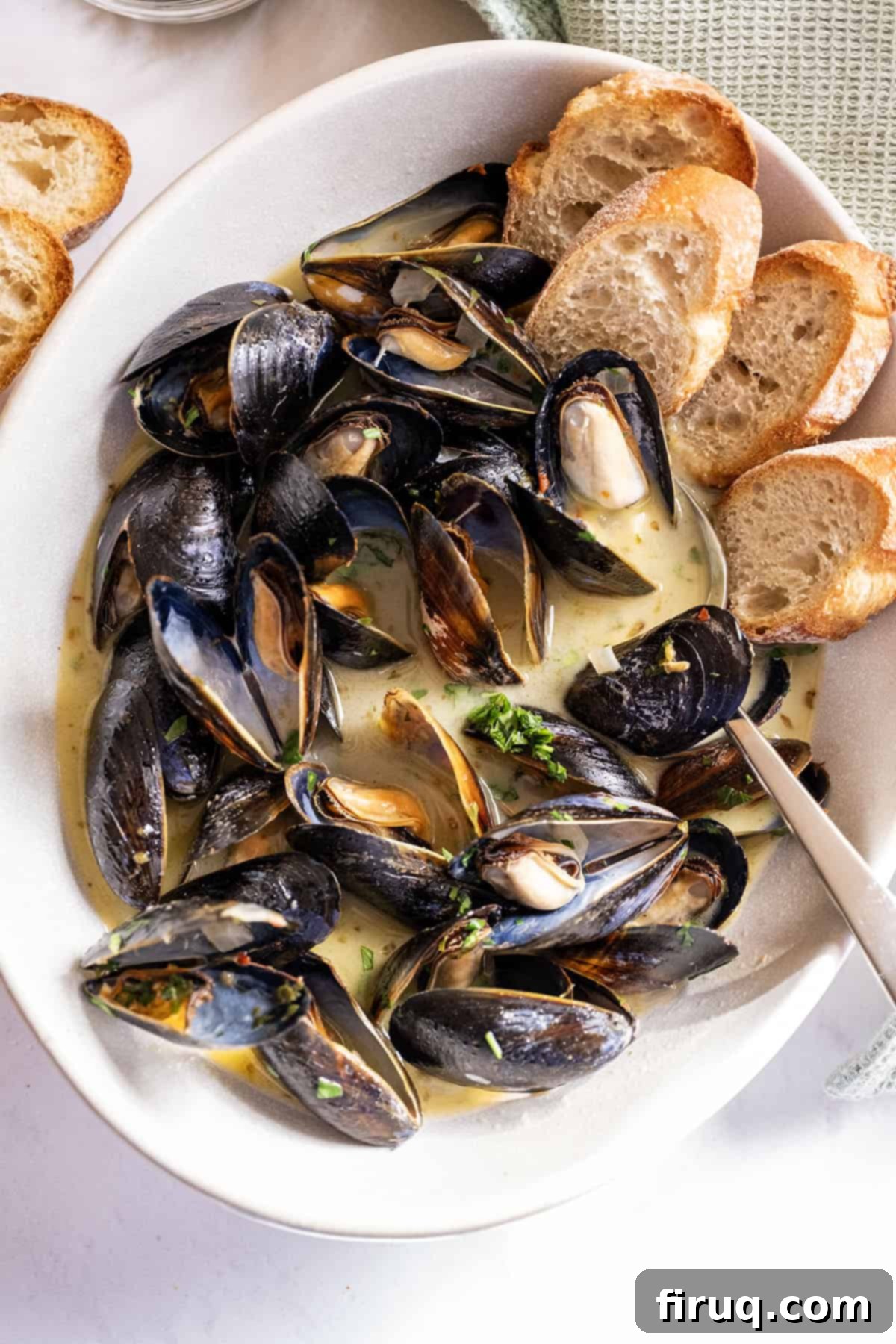
Pro-Tips for Perfect Mussels Every Time
- When sautéing the garlic, observe for little bubbles exiting the garlic. This indicates it’s releasing its flavor. The key is to avoid any browning, as browned garlic can turn bitter and overpower the delicate mussel flavor. Keep the heat gentle and watch it closely.
- The mussels will open on their own when they are fully cooked and steamed. There’s no need to force them open. Resist the urge to pry them open, as this could damage them. Once the shells have opened, they are ready to be enjoyed. Always discard any mussels that do not open during the steaming process, as they were likely dead before cooking and are not safe to eat.
- If you find a mussel that is open before you even start steaming, it’s not necessarily dead. You can perform a quick test: tap gently on the side of the shell. If the mussel responds by closing its shell within a few seconds, it is still alive and safe to cook. If it remains stubbornly open, then it should be discarded. This simple check helps prevent food waste while ensuring safety.
Serving Suggestions: What to Pair with Steamed Mussels in White Wine Sauce
I absolutely adore steamed mussels in white wine because of their incredible versatility. They can shine as a standalone dish, effortlessly transforming from a casual appetizer to the star of a full meal. Growing up, a large tray of these mussels was always a staple at our holiday gatherings, enjoyed from the very start of appetizers all the way through dinner.
For an impressive spread of appetizers, serve your mussels alongside other Italian-inspired small bites like a vibrant Eggplant Caponata, a savory Veggie Stromboli, or a creamy yet mayo-free Spinach and Artichoke Dip. The light, bright flavors of the mussels will complement these richer options beautifully.
If you’re planning a traditional Christmas Eve “Feast of the Seven Fishes,” these mussels are a must-add. They pair wonderfully with other seafood delights such as crispy Fried Flounder Oreganata, a classic Linguine with Red Clam Sauce, or a perfectly seared Pan-Seared Vermillion Snapper. The white wine sauce offers a different flavor profile, adding variety to your seafood banquet.
Beyond appetizers, this is also a fantastic dish that can be served directly over angel hair pasta, transforming it into a complete and satisfying meal. The delicate strands of pasta soak up every bit of the flavorful white wine sauce, creating a light yet incredibly delicious entree that’s both elegant and comforting. It’s perfect for a weeknight dinner or a special occasion.
Since we typically enjoy this dish on Christmas Eve, make sure to have a delicious dessert ready to round out the meal. Consider our delightful Cranberry Orange Shortbread Cookies or a luxurious Pistachio Cream Tiramisu, especially if you make it with our Homemade Ladyfingers Recipe. The light seafood main course allows for a richer, more indulgent dessert.
Recipe FAQs: Your Questions Answered
I highly recommend using a dry white wine such as Sauvignon Blanc or Pinot Grigio. These wines offer a crisp, bright, and acidic flavor profile that perfectly complements the delicate taste of mussels. They won’t overpower the seafood but instead enhance the overall freshness of the dish. A general rule of thumb when cooking with wine is to always use a wine that you would enjoy drinking on its own. If it’s not good enough to sip, it’s not good enough for your mussels!
Mussels cook very quickly! They typically take anywhere from 3 to 5 minutes to steam in a covered pot. You’ll know they are perfectly done when all of their shells have opened wide. It’s crucial to remove them from the heat promptly once opened to prevent them from becoming tough or rubbery. Remember to discard any mussels that remain closed after cooking, as they were likely dead before steaming and are unsafe to eat.
Eating mussels is part of the fun! Use a serving spoon to transfer a generous portion of mussels and the flavorful white wine sauce to your plate. You can use a small fork to gently pry the meaty part of the mussel from its shell. Once removed, dunk it directly into the rich, buttery sauce for an explosion of flavor. Don’t forget the ultimate indulgence: use slices of crusty Italian bread or toasted crostini to soak up every last drop of that incredible sauce. It’s truly a highlight of the meal!
Absolutely! If you prefer to avoid alcohol or don’t have white wine on hand, you can substitute it with an equal amount of chicken or vegetable broth. While the flavor profile will be slightly different – less bright and acidic – it will still create a delicious and aromatic steaming liquid for your mussels. A squeeze of fresh lemon juice at the end can help add back some of that bright acidity that the wine would provide.
Leftover cooked mussels should be cooled quickly and stored in an airtight container in the refrigerator. Consume them within one day for best quality and safety. Reheat gently on the stovetop over low heat, adding a splash of wine or broth if the sauce has thickened. It’s generally not recommended to reheat mussels multiple times, and avoid freezing cooked mussels as it can significantly alter their texture.
Explore More Delicious Seafood Recipes
If you’ve enjoyed the delightful experience of these steamed mussels, we invite you to dive into our collection of other incredible seafood recipes. Each dish is crafted to bring fresh, vibrant flavors to your table, whether you’re looking for a quick weeknight meal or an impressive dish for entertaining.
- Garlic Anchovy Pasta with Toasted Breadcrumbs
- Pistachio Crusted Fish
- Lemon Garlic Broiled Flounder
- Cast Iron Lemon Dill Salmon
We absolutely love hearing from you! Please leave a comment and a star rating below in the recipe card if you try this fantastic recipe. Your feedback helps us improve and grow our community. Also, feel free to tag us on Instagram @vindelgiudice to share your culinary creations!
📖 Recipe
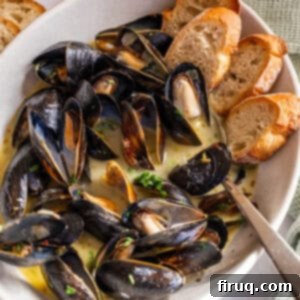
Steamed Mussels in White Wine
Vincent DelGiudiceEquipment
- 1 large saucepan
Ingredients
- 2 pounds Mussels
- 3 cloves garlic, minced
- 1 shallot, chopped
- 1 teaspoon oregano
- 1 teaspoon crushed red pepper
- 1 cup white wine
- ½ cup water
- 2 tablespoon extra virgin olive oil
- 2 tablespoon fresh chopped parsley
- ½ teaspoon salt
- 3 tablespoon butter
Instructions
- Rinse and debeard your mussels thoroughly under cold running water. Most farm-raised mussels will come already debearded, but it’s always a good practice to double-check and remove any lingering “beards.” Carefully inspect each mussel and discard any cracked, chipped, or open shells that do not close when tapped.
- In a large saucepan or Dutch oven, heat the extra virgin olive oil over medium-low heat. Add the chopped shallots and sauté gently, stirring occasionally, until they become soft and translucent (about 5 minutes). Then, stir in the minced garlic, crushed red pepper flakes, and dried oregano. Continue to sauté for another 1-2 minutes, just until the garlic is fragrant but still pale, being careful not to let it brown.
- Pour in 1 cup of dry white wine and ½ cup of water (or broth). Increase the heat to medium and bring the liquid to a gentle simmer. Stir in 1 tablespoon of fresh chopped parsley, allowing the flavors to meld for about 3 minutes.
- Add the cleaned mussels to the simmering liquid. Cover the pan tightly with a lid and steam for 3-5 minutes, maintaining a low simmer. The mussels are cooked when their shells have opened. Once opened, give them a gentle stir to baste them thoroughly in the flavorful sauce. Using a slotted spoon, carefully remove the opened mussels from the pan and transfer them to a large serving bowl. Discard any mussels that did not open.
- Return the saucepan with the remaining sauce to the stove. Add the 3 tablespoons of cold butter to the sauce. Stir vigorously until the butter has completely melted and is fully incorporated, creating a rich, velvety sauce. Pour this delectable sauce generously over the mussels in the serving bowl. Serve immediately with plenty of toasted crostini or crusty Italian bread for dipping, and garnish with an extra sprinkle of fresh parsley for vibrant color and freshness. Enjoy!
Notes
-
- When sautéing the garlic, look for little bubbles exiting the garlic but be careful not to let it brown. Browning garlic can lead to a bitter taste that will affect the delicate flavor of the sauce.
- The mussels will open on their own during steaming when they are cooked. Do not try to force them open. Any mussels that do not open during this time should be discarded, as they were likely dead before cooking and are not safe to consume.
- If a mussel is found open before you begin steaming, it might still be alive. You can verify this by gently tapping on the side of the shell. If it closes up, it is still safe to eat. If it remains open, discard it.
